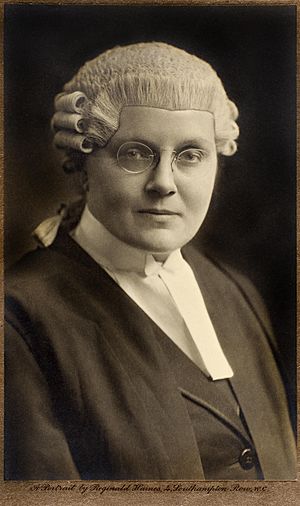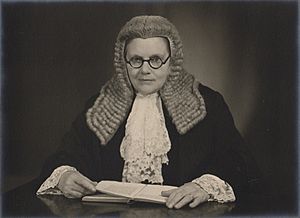Helena Normanton facts for kids
Quick facts for kids
Helena Normanton
|
|
|---|---|
 |
|
| Born |
Helena Florence Normanton
14 December 1882 East London, England
|
| Died | 14 October 1957 (aged 74) Sydenham, London, England
|
| Known for | One of the first female barristers, campaigner for women's rights, pioneer of divorce reform, and the first married woman to hold a British passport in her own name, after she declined to take on her husband's surname. |
Helena Florence Normanton (born December 14, 1882 – died October 14, 1957) was a very important woman in British history. She was the first female barrister in the United Kingdom. A barrister is a type of lawyer who speaks in court.
In November 1922, she became the second woman to officially become a barrister in England and Wales. This happened shortly after Ivy Williams became the first. When Helena married, she decided to keep her own last name. In 1924, she became the first married British woman to have a passport in her birth name. In 2021, a special Blue plaque was placed on her London home to honor her achievements.
Contents
Early Life and Education
Helena Normanton was born in East London. Her parents were Jane Amelia and William Alexander Normanton, who made pianos. When Helena was only four years old, her father died. Her mother raised Helena and her younger sister, Ethel, by herself.
To support her family, Helena's mother rented out rooms in their home. Later, they moved to Brighton, where her mother ran a grocery store and then a boarding house.
School Days
In 1896, Helena won a scholarship to the York Place Science School in Brighton. This school is now called Varndean School for Girls. She was a very good student and became a pupil teacher before leaving in 1900.
After her mother passed away, Helena became responsible for her sister. She helped manage the family's boarding house. From 1903 to 1905, she studied at a teachers' training college in Liverpool, called Edge Hill.
Further Studies and Early Career
Helena also studied modern history at the University of London as an external student. She earned top honors. She also got a diploma for teaching in Scotland and a diploma in French from Dijon University.
She taught history at Glasgow University and London University. Helena also started to speak and write about issues important to women. She even worked as a tutor for the sons of a politician, Baron de Forest. She supported groups like the Women's Freedom League and the Indian National Congress.
Becoming a Lawyer
Helena Normanton decided she wanted to become a barrister when she was young. She wrote about this moment in her book, Everyday Law for Woman. When she was twelve, she went with her mother to a lawyer's office. Her mother found it hard to understand the lawyer's advice.
Helena realized that women often faced challenges in understanding the law. She wanted to help all women have better access to legal help. At that time, only men could be lawyers.
She wrote: "I still do not like to see women getting the worst end of any deal for lack of a little elementary legal knowledge."
Breaking Barriers in Law
In 1918, Helena tried to become a student at Middle Temple, a place where barristers train. She was refused because she was a woman. She then made a formal complaint to the House of Lords.
On December 24, 1919, a new law called the Sex Disqualification (Removal) Act 1919 came into effect. This law made it illegal to stop people from certain jobs just because of their gender. Within hours of the law passing, Helena applied again to Middle Temple and was accepted!
In 1921, she married Gavin Bowman Watson Clark. But she kept her maiden name for her professional work. In 1924, she became the first married British woman to get a passport in her birth name.
On November 17, 1922, Helena became the second woman to be officially called to the Bar. This happened shortly after Ivy Williams. Helena was also the first woman to:
- Get a divorce for a client.
- Lead the prosecution in a murder trial.
- Conduct a trial in America.
- Appear at the High Court and the Old Bailey (a famous court in London).
In 1949, Helena Normanton and Rose Heilbron became the first two women to be named King's Counsel. This is a special title for very experienced barristers.
Fighting for Women's Rights
Helena Normanton was a strong supporter of women's rights and the right for women to vote. She believed that men and women should keep their money and property separate. She was also a pacifist, meaning she believed in peace and was against war. Later, she supported the Campaign for Nuclear Disarmament (CND).
Speaking Out
In July 1929, ten years after the Sex Disqualification (Removal) Act became law, Helena spoke at a conference for the Women's Engineering Society. She spoke alongside other important women like Professor Winifred Cullis and architect Edna Mosley.
In her speech, Helena pointed out that there were many talented women lawyers. She said:
nearly a hundred women solicitors in this country and most of them have brilliant qualifications; she did not believe in any boycott of men in professions, but the women ought at least to be brought into the sphere of action. There was a general muddle as present in regard to the position of women...They might become engineers but not ministers of the Church; they might not enter the sacred portals of the Stock Exchange nor the House of Lords; they could become a Cabinet Minister but not an Ambassador. While any woman was held back from the position to which her talents drew her, the whole of womanhood was lowered.
Helena was the Honorary Legal Adviser for the Women's Engineering Society from 1936 to 1954.
She also worked hard to change divorce laws. She was president of the Married Women's Association until 1952. She later formed a new group called the Council of Married Women.
Helena also founded the Magna Carta Society. She remained a pacifist throughout her life and protested against nuclear weapons after World War II.
Personal Life
Helena Normanton was married to Gavin Bowman Watson Clark, who was an accountant. They lived in London.
Helena Normanton passed away in Sydenham, London, on October 14, 1957. She was cremated and buried with her husband in Ovingdean churchyard, Sussex.
Her Legacy
In 1957, Helena Normanton was the first person to leave money to the University of Sussex. This university opened in 1961, and she is known as a founding funder. She wrote that she made this gift "in gratitude for all that Brighton did to educate me when I was left an orphan."
In 2015, the Helena Normanton Society was created in her honor at the University of Sussex. A special scholarship, the Helena Normanton Doctoral Fellowship, was also started there in 2017.
Her personal papers and records are kept at The Women's Library at the Library of The London School of Economics.
In February 2019, a group of barristers' offices, 218 Strand Chambers, changed its name to Normanton Chambers to honor her. This was the first time a barristers' chambers was named after a woman.
In 2020, a lawyer named Karlia Lykourgou started a company that makes court clothes for women. She named it Ivy & Normanton, to honor both Ivy Williams and Helena Normanton.
In April 2021, English Heritage announced that Helena Normanton would be honored with a Blue plaque. This plaque marks the house where she lived from 1919 to 1931, during the early part of her legal career. The plaque was put up in October 2021 by Brenda Hale, the first female head of the Supreme Court.
In June 2022, another blue plaque was placed at 4 Clifton Place, Brighton. This was where Helena lived as a teenager in the 1890s. This plaque was put there after a campaign by two teenage twins from Brighton who learned about Helena in a school project.
See also
 In Spanish: Helena Normanton para niños
In Spanish: Helena Normanton para niños
- First women lawyers around the world


